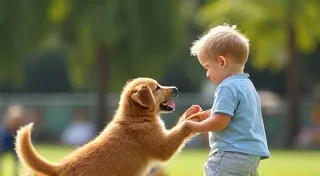Understanding Dog Body Language: What Your Pup is Trying to Tell You
Have you ever looked at your dog and wondered what they were *really* thinking? Dogs can't talk, but they communicate volumes through their body language. Learning to decipher these signals can dramatically improve your understanding of your pup, strengthen your bond, and even prevent potential behavioral issues. This guide will break down common dog body language cues and what they might signify.
The Tail: More Than Just a Wag
The classic tail wag isn't always a sign of happiness! While a wide, relaxed wag generally indicates positive emotions, the specifics matter. Understanding these nuances is crucial for interpreting what your dog is trying to say. For instance, a dog with seemingly boundless energy and a constantly wagging tail might benefit from the focused exercise and mental stimulation common to breeds like the Jack Russell Terrier.
- High, Fast Wag: This can indicate excitement, but also agitation or anxiety. Pay attention to the rest of the dog’s body to determine the overall mood.
- Low, Slow Wag: Often signals uncertainty, insecurity, or appeasement.
- Tail Tucked: A sign of fear, submission, or pain.
- Stiff Tail: Can indicate alertness or potential aggression.
Ears: Attentiveness and Mood
A dog's ears are highly expressive. Their position gives clues about their attentiveness and emotional state. Breed-specific ear shapes can make interpretation more complex; a breed spotlight on a Border Collie, for example, highlights the important role of their ears in herding and observing. The differences in ear carriage and its significance can vary greatly, and understanding these distinctions is key to accurately interpreting canine communication.
- Ears Forward: Usually indicates alertness, interest, or curiosity.
- Ears Back: Can signify fear, submission, or nervousness. In some breeds, relaxed ears back are normal.
- Ears Drooping: May indicate sadness, relaxation, or fatigue.
A dog’s eyes reveal a lot about how they’re feeling. Look for these cues:
- Soft Eyes: Relaxed and comfortable.
- Hard Stare: Can be a sign of challenge or aggression.
- Whale Eye (showing the whites of the eyes): Often indicates discomfort, anxiety, or a desire to avoid interaction.
- Avoiding Eye Contact: Often a sign of submission or fear.
Consider the dog's entire body. These cues work together to paint a clearer picture of their emotions. A dog’s overall posture is hugely important, and understanding this is a key part of building a strong bond. Understanding the nuances of body posture can also provide insight into potential underlying health conditions – a subtle shift in gait, for instance, might be a sign of pain or discomfort.
- Relaxed Body: Weight evenly distributed, muscles loose, mouth slightly open. The dog is comfortable and at ease.
- Tense Body: Muscles stiff, weight shifted forward, tail held high. The dog is alert, potentially stressed, or preparing to react.
- Cowering/Leaning Away: Signifies fear, anxiety, or submission.
- Freezing: A moment of stillness before reacting – often indicating fear or a feeling of being threatened.
Decoding Specific Behaviors: A Closer Look
Let's dive deeper into some specific behaviors and what they *really* mean. It's not enough to just see a wagging tail; you need to consider the context. A dog’s body language is a complex language of subtle cues. The environment and the dog’s individual history play a significant role in shaping their responses and behaviors, making comprehensive observation even more critical.
Lip Licking and Yawning: More Than Just Tiredness
While lip licking can simply mean your dog wants a drink, it frequently indicates stress or anxiety. Similarly, a yawn isn't always a sign of tiredness; it can be a displacement behavior, a way for a dog to release tension when feeling uncomfortable. These are subtle signs that need careful observation.
The "Play Bow": An Invitation to Fun
The play bow – when a dog lowers their front end while keeping their rear end up – is a clear invitation to play. It’s a non-threatening gesture meant to signal friendly intentions. Recognizing this signal can help you better interact with other dogs. However, misinterpreting this signal can sometimes lead to unintended consequences, particularly with dogs who have a history of reactivity or anxiety.
Freezing and Stiffening: Signs of Potential Conflict
When a dog freezes or stiffens, it's often a precursor to either a flight or fight response. This is a moment to carefully assess the situation and remove your dog from any potential conflict. Often, understanding breed-specific traits can help predict these behaviors; a breed known for its guarding instincts, for example, might display increased stiffness in the presence of perceived threats.
Common Signs of Anxiety and Stress
Recognizing signs of stress is key to helping your dog feel safe and comfortable. Chronic stress can lead to behavioral problems and health issues, so early intervention is crucial. Providing a safe and predictable environment is paramount to a dog's overall wellbeing. It're also important to rule out any underlying medical conditions that might be contributing to these signs of stress.
- Panting (when not hot): Can indicate stress or anxiety.
- Licking Lips: Often a sign of stress.
- Yawning (when not tired): A displacement behavior indicating discomfort.
- Trembling: Can be a sign of fear or anxiety.
- Excessive Shedding: Can be triggered by stress.
Understanding Breed-Specific Body Language
It’s important to remember that body language can vary between breeds. For example, a breed with naturally droopy ears, like a Basset Hound, might use their ears differently than a breed with erect, attentive ears like a German Shepherd. Similarly, certain breeds have been bred for specific purposes, and their body language might reflect those traits. For instance, some breeds, known for their independence, might exhibit more subtle body language cues that require keen observation to decipher.
Improving Communication and Building a Stronger Bond
Learning to read dog body language is an ongoing process. Pay close attention to your dog's individual cues, as breed and personality can influence their signals. By understanding what your dog is trying to tell you, you can respond appropriately, build trust, and create a deeper, more fulfilling relationship. Remember to always be patient and empathetic – your dog will appreciate your efforts to understand their world. If you're dealing with a particularly energetic or challenging dog, exploring breeds with similar traits might offer a better understanding, perhaps a Jack Russell Terrier for example, to better understand the breed’s tendencies.
Beyond Basic Cues: Recognizing Subtle Signals
While the signs discussed thus far are relatively common, expert dog communicators often recognize much more subtle signals. These can include micro-expressions, shifts in weight, and changes in muscle tension that are nearly imperceptible to the untrained eye. Paying attention to these subtle details can provide a richer understanding of a dog’s emotional state and intentions. Consider, for example, the importance of a dog's gait and the slight variations it may exhibit based on environmental conditions or perceived threats.
The Role of Context and Environment
It's crucial to remember that body language must always be interpreted within its context. A tail wag, for example, can signify happiness, excitement, or even anxiety depending on the other cues the dog is displaying and the situation they are in. A dog who is normally calm and confident might exhibit signs of stress if they are in a crowded or noisy environment. Learning to read a dog's body language requires not only understanding individual cues, but also recognizing how they interact with each other and the surrounding environment.
Further Resources and Professional Guidance
Decoding dog body language is a lifelong learning process. There are numerous books, articles, and online resources available to help deepen your understanding. For those struggling to interpret their dog’s behavior, seeking guidance from a qualified dog trainer or behaviorist can be invaluable. A professional can help identify underlying issues and develop strategies for improving communication and strengthening the bond between you and your dog.





